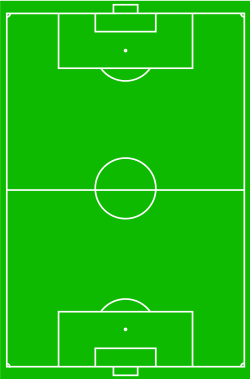In the sport of association football, each of the 11 players on a team is assigned to a particular position on the field of play. A team is made up of one goalkeeper and ten outfield players who fill various defensive, midfield, and attacking positions depending on the formation deployed. These positions describe both the player's main role and their area of operation on the pitch.
In the early development of the game, formations were much more offensively aggressive, with the 1–2–7 being prominent in the late 1800s.[1] In the latter part of the 19th century, the 2–3–5 formation became widely used and the position names became more refined to reflect this. In defence, there were full-backs, known as the left-back and right-back; in midfield, left-half, centre-half and right-half; and for the forward line there were outside-left (or left wing), inside-left, centre-forward, inside-right and outside-right (or right wing). As the game has evolved, tactics and team formations have changed and so many of the names of the positions have changed to reflect their duties in the modern game (though some old familiar ones remain).[1] The term "half-back" fell out of use by the early 1970s and "midfield" was used in naming the positions that play around the middle third as in centre midfield and wide midfield.[1]
The fluid nature of the modern game means that positions in football are not as rigidly defined as in sports such as rugby or American football. Even so, most players will play in a limited range of positions throughout their career, as each position requires a particular set of skills and physical attributes. Footballers who are able to play comfortably in a number of positions are referred to as "utility players".[2]
However, in Total Football tactics, the players are only loosely defined into a position. This tactic required players who were extremely versatile, such as Johan Cruyff, who could play every position on the pitch apart from goalkeeper.[3]
- ^ a b c "Old football formations explained - Classic soccer tactics & strategies". Football Bible. n.d. Archived from the original on 5 July 2019. Retrieved 31 March 2016.
- ^ "Bolton sign Portmouth utility man Taylor". Reuters. 17 January 2008. Archived from the original on 21 June 2009. Retrieved 5 June 2008.
- ^ The total footballer, BBC Sport Academy, Accessed 5 June 2008
